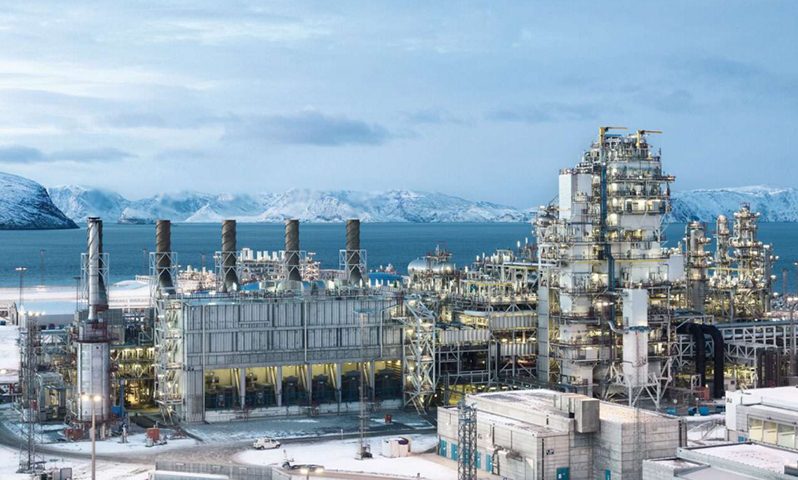Snøhvit literally meaning, “Snow White”, consists of 3 fields in 250-345 m of water at Snøhvit, Albatross and Askeladd. These resources were discovered in 1984 in the Barents Sea, about 140 km north-west of Hammerfest in northern Norway. In 1991 a development plan was proposed but was subsequently shelved on budgetary concerns. 10 years later, in September 2001 Statoil proposed development and operation of the field and received approval for the project in March 2002. The initial planned budget of approximately US$ 5.3 Billion was ultimately overrun by almost US$ 1.6 Billion.
The island of Melkøya was selected for the onshore facilities. Excavation of 3 million cubic meters of rock and construction of a solid breakwater wall, increased the island’s size from 175 acres to 250 acres. A subsea production system feeds the onshore plant through a 160 km long submarine gas pipeline. The original plan projected LNG deliveries by October 2006, however budgetary increases extended the schedule to 2007.
In the initial phase, long-term export contracts were signed with Iberdrola in Spain and El Paso in the USA. The annual export capacity of the plant is 4.3 MMTPA of LNG, 747,000 tons of condensate and 247,000 tons of liquefied petroleum gas. Melkøya ships approximately 70 cargos of LNG per year and in 2014 witnessed its 500th cargo. The life of the plant is projected to be 25-30 years.
In the construction phase nearly six thousand people from 38 nationalities worked on the plant in Melkøya, of which 1200 came from the northernmost counties of Norway. Approximately 170 persons work at the plant during regular operations. Around 300 – 350 new jobs were generated in the area because of support personnel and consumer demand. Local deliveries have been estimated at approximately US$ 230 Million1, which total almost three times the original projections.
Snøhvit LNG is one of the first in the industry that fully processes return gases from loading of LNG and LPG carriers. It is also claimed as the first land-based industrial development that uses technology for CO2 sequestration involving offshore reservoirs. The plant has a carbon dioxide capture and storage facility situated 2.6 km under the seabed. A 153 km pipeline is used for reinjection of approximately 700,000 tons of carbon dioxide annually.
OWNERSHIP (Equity %)
| Statoil | 33.53% |
| Petoro | 30.00% |
| Total | 18.4% |
| Gaz de France | 12% |
| Amerada Hess | 3.26% |
| RWE-DEA | 2.81% |
General Data
| Estimated Capital Cost (USD) | 5.9 B |
| Plant Type | Onshore Modular |
| Plant Stage | Operating |
| Final Investment Decision (FID) Year | 2002 |
| FEED Contractor | KBR Inc. Bechtel Linde |
| EPC Contractor | Linde AG |
| No. of Trains / capacity | 1 Train / 4.3 MMTPA |
| Production Start Year | 2008 |
| Products | LNG, LPG & Condensate |
| Gas Type | Non Associated Gas |
Technical Data
| Cooling Media | Seawater |
| Liquefaction Technology | Linde Mixed Fluid Cascade (MFC)® |
| Refrigeration Train Details: | |
| Mixed Refrigerant String 1 | |
| Driver | Siemens 65 MW Synchronous Motor with variable speed drive system (VSDS) |
| Precooling Cycle (PCC) Compressor | 3MCL1404 GE (Nuovo Pignone) Horizontally Split Centrifugal Compressor |
| Mixed Refrigerant String 2 | |
| Driver | Siemens 32 MW Synchronous Motor with variable speed drive system (VSDS) |
| Liquefaction Cycle (LCC) Compressor | MCL1406 GE (Nuovo Pignone) Horizontally Split Centrifugal Compressor |
| Mixed Refrigerant String 3 | |
| Driver | Siemens 65 MW Synchronous Motor with variable speed drive system (VSDS) |
| Stage 1 Subcooling Cycle (SCC) Compressor | MCL1406 GE (Nuovo Pignone) Horizontally Split Centrifugal Compressor |
| Stage 2 Subcooling Cycle (SCC) Compressor | BCL1007 GE (Nuovo Pignone) Radially Split Centrifugal Compressor |
| Power Generation | Qty: 5 GE LM6000 PD DLE Aeroderivative Gas Turbines |
Refrigeration Train Configuration

Key Facts
- Up until 2017, Snøhvit was Europe and the world’s northernmost LNG export plant. Yamal LNG now has that distinction.2
- Snøhvit is Europe’s first Oil & Gas facility to use a subsea production platform which feeds gas via 143 km of pipeline with multiphase flow.3
- Snøhvit was the first land-based industrial development to use technology for CO2 sequestration involving offshore reservoirs. The CO2 capture and storage reservoir is located 2.6 km beneath the seabed of the Snøhvit field and a 153 km pipeline is utilized for reinjection. The facility can store 700,000 tons of carbon dioxide annually.3
- The Snøhvit LNG plant is the first application of the Statoil-Linde developed Mixed Fluid Cascade (MFC®) liquefaction process. Several alternative liquefaction processes were evaluated by Statoil including the APCI Propane precooled mixed refrigerant process, ConocoPhillips’ Optimized cascade process and the APCI dual mixed refrigerant (DMR) process. An inherent characteristic of the MFC® process is low specific compressor power requirement.4
- The energy efficiency of the liquefaction facility is 70%, which is the highest achieved in any plant of this kind across the world.3
- Snøhvit LNG plant was the first LNG plant in the world to employ an all-electric drive system for the refrigeration compressors. The plant incorporates two 65MW and one 32MW synchronous motors with load-commutated inverter drives (for start-up and variable speed control) for the three mixed refrigerant compression strings. The design of the Snøhvit variable speed drive system was a major extension of the technology and required extensive testing to assure that the torsional natural frequencies of the train did not coincide with integer and non-integer harmonics of the drive and power system.
- During the initial operational years, the refrigeration compressor driver synchronous motors experienced failures of the stator winding. A new stator design was implemented by the OEM to address the issue. 5
- Snøhvit LNG had a troubled start-up period that saw it shut down several times after it came onstream in September 2007. A large number of shutdowns were related to tube failures in the HelixChanger® seawater heat exchangers due to flow induced vibrations. The heat exchangers used were a novelty application. Statoil shut down production from the field from June 2009 to November 2009 for repair and upgrades of the onshore plant cooling system. The mixed refrigerant (MR) condenser was also replaced.5
- Due to the extreme weather conditions in northern Norway and lack of infrastructure, a pre-fabrication policy was adopted by Statoil to outsource much of the construction away from the Melkøya Island where most of the modules were built in mainland Europe. Dragados Offshore, Spain assembled this facility on a 35,000-tonne steel barge measuring 154 m long, 54 m wide and 9 m deep and it serves as the foundation for the LNG process plant. The LNG plant is subdivided into smaller, pancake-type structural sections that could be assembled easily on the barge – i.e., a stick-build approach – following pre-fabrication in the company’s workshops. The slug-catcher and MEG regeneration units were built by Heerema Marine Contractors, Holland; the pipe racks and electricity substations were built by Fabricom, Belgium and Smulders Group, Netherlands did production and assembly of transport frames, stair tower, pipe support and secondary steel for the Cold-box-structure bearing height of 74m. 6,7
Source:
1. Snohvit LNG project an Arctic success , Helion ltd Website
2. Snohvit , Equinor Website
3. Snohvit LNG Export Terminal, Melkoya Island, Hammerfest, Norway, Hydrocarbons Technology Website
4. Heiersted R., Lillesund S. et al ‘The Snøhvit Design Reflects a Sustainable Environmental Strategy’
5. Bauer, H. ‘Highly efficient and clean LNG plant concept’, 25th World Gas Conference, 2012
6. Statoil to begin Snøhvit LNG operations by yearend 2007 by Odd Arild Mosbergvik, Oil & Gas Journal Website, 9 April 2007
7. Statoil Snohvit Coldbox, Hammerfest, Norway, Smulders Website, 2004





















































